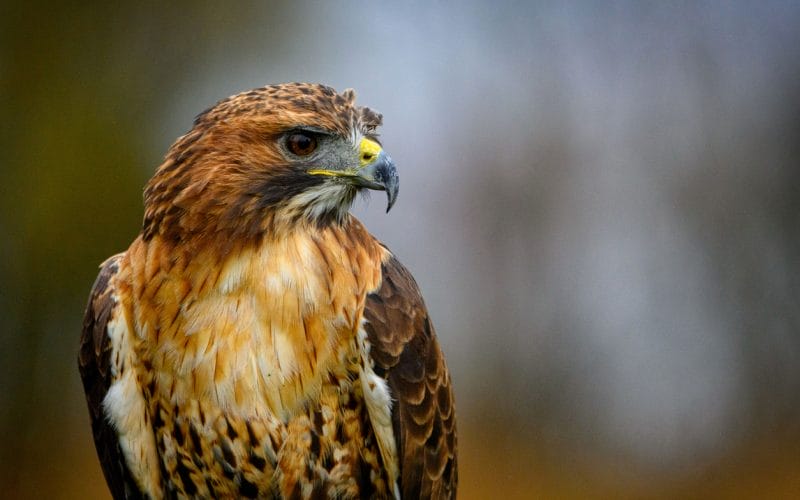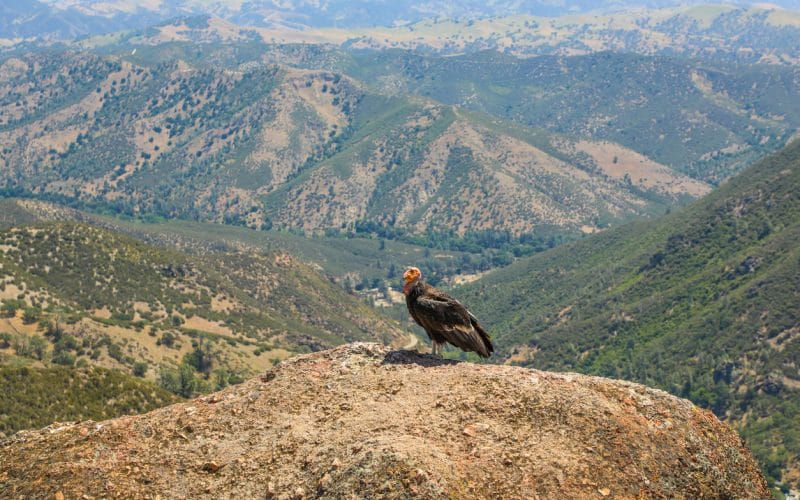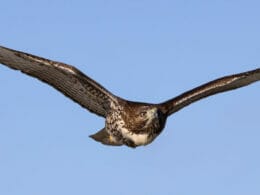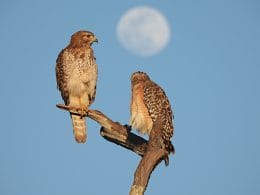Oregon is full of interesting attractions like the Witch’s Castle and Thor’s Well, making it one of the most fun places to visit in the Northwest region of the US.
With about 120 important bird areas, it’s also home to 544 bird species that are either found all year long or visit Oregon during the warmer months. Many of these sites are visited by birding enthusiasts to study and watch these fascinating creatures.
Learning about Oregon birds of prey is fun, as you get to see how these skilled hunters live their lives. Here in this article, we’ll learn about the most famous raptors that you might encounter in Oregon.
12 Oregon Birds of Prey
Birds of prey are apex predators that play a crucial role in maintaining balance in their ecosystems. Raptors usually hunt live prey, but some of them also feed on carcasses. In this section, we’ll talk about the most common birds of prey that you can find in Oregon.
1. Ferruginous Hawk
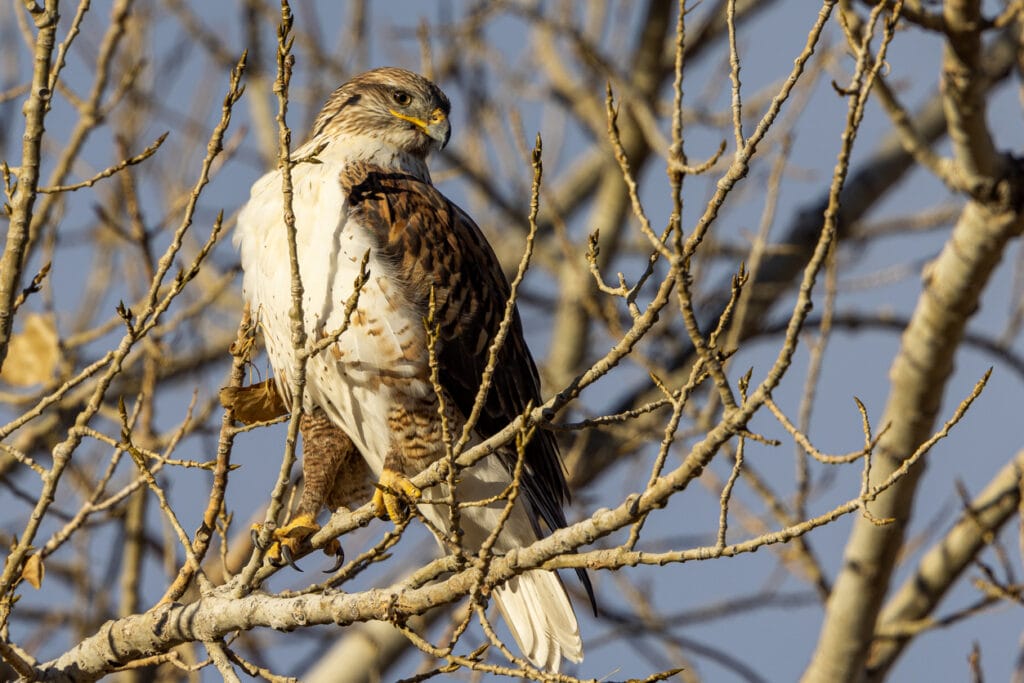
The Ferruginous Hawk is the largest hawk that can be found in Oregon. It’s not commonly found in the open landscapes on the east of the Cascades, but it can be spotted along the foothills of the Blue Mountains, in addition to the northern region of Malheur County. It’s listed as a sensitive species on the Oregon Conservation Strategy Species list.
Author Note: Light-morph hawks are more common in Oregon than dark-morph ones. These birds have white underparts with some markings, and the back and wings are rusty.
It has a limited diet that’s made mostly of small mammals like cottontail rabbits and jackrabbits. It uses four methods for hunting its prey, either by chasing its prey on the ground, attacking it from a perch, searching for it while flying, or hovering in place to spot it. It occasionally feeds on reptiles, amphibians, and birds.
2. Golden Eagle
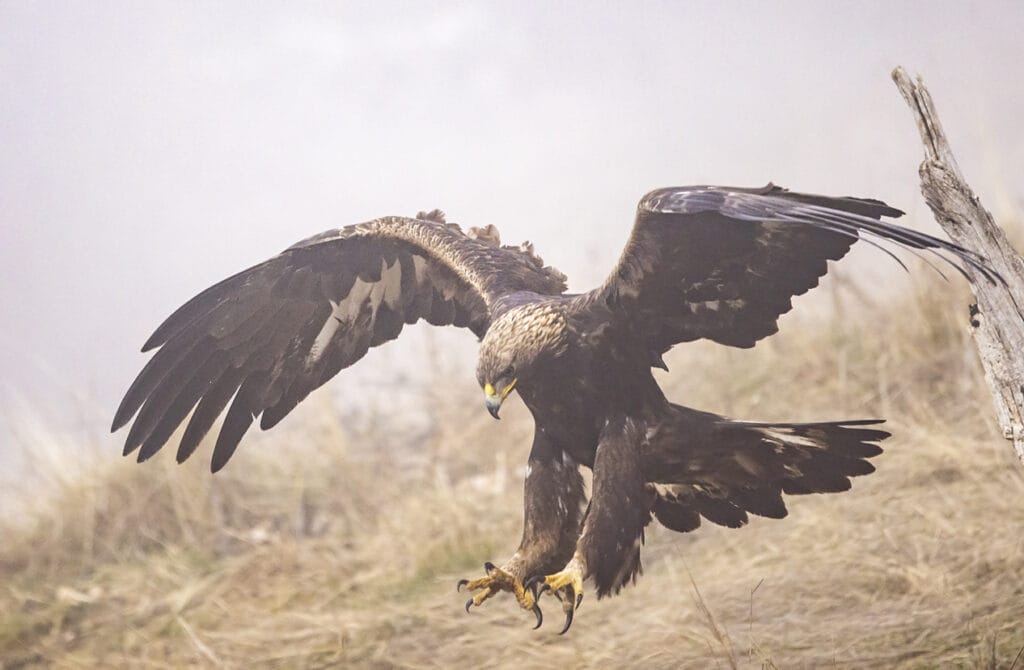
The Golden Eagle is a common resident in the counties that are located east of the Cascade range in Oregon, as it’s one of the most well-known raptors in North America. The Golden Eagle is brown with a golden sheen on the head and neck.
It’s usually found alone, but sometimes it hunts in pairs, usually targeting its prey from a perch or catching it on the ground. Due to its majestic traits, the Golden Eagle is by far the most official national animal in the world, as it’s the national emblem of Mexico, Austria, Kazakhstan, Germany, and Albania.
This eagle lives in open and semi-open country areas, usually avoiding developed areas and uninterrupted forests. It usually feeds on small to medium-sized mammals like prairie dogs, squirrels, hares, rabbits, and dogs, although it can take larger prey like wild ungulates and livestock.
3. California Condor
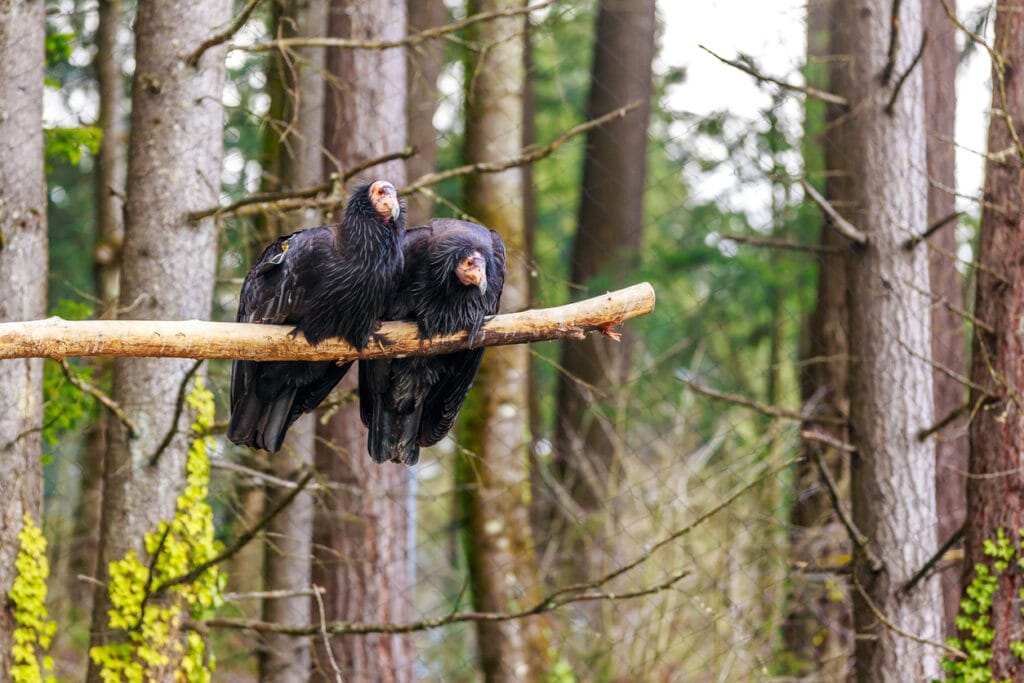
The California Condor is a New World vulture that’s originally native to Oregon, but currently, there are about only 400 members of this species that you can see if you’re visiting the state. Only half of these birds are flying free.
This is the largest bird in North America and is considered endangered, although protection efforts are hoping to change its status. It’s mostly black with some white feathers on the wings’ undersides, and the head is bald.
It has the widest wingspan among North American birds that measure about 9.8 feet, and it weighs about 20 pounds.
Top Tip: Unlike other birds of prey, the female is smaller than the male. These birds are skilled soarers and rarely flap their wings. California Condors are social birds that form groups around carcasses and at bathing spots.
It mainly feeds on the carrion of land and marine animals, including deer, pigs, cattle, rabbits, and even whales and sea lions. However, it prefers small to medium carcasses because the bones can be easily digested. Birds nest in cave cliffs and other natural cavities.
4. Great Horned Owl

14 species of typical owls live in Oregon, but the Great Horned Owl is the most common one. It can be found in different habitats, from city parks to urban areas, woodlands, and deserts.
The Great Horned Owl is one of the biggest owls and has a mottled brownish-gray body with big rounded wings and a slightly reddish face. It has yellow staring eyes and a deep hooting sound, which explains why it’s also called the hoot owl.
When the owl is roosting, its earlike tufts provide a good camouflage to keep the bird concealed. It’s known to take prey that’s usually larger than itself, including other raptors like hawks, Ospreys, and smaller owls.
However, it also feeds on small mammals, rodents, birds, amphibians, reptiles, and arthropods like scorpions.
5. Sharp-shinned Hawk
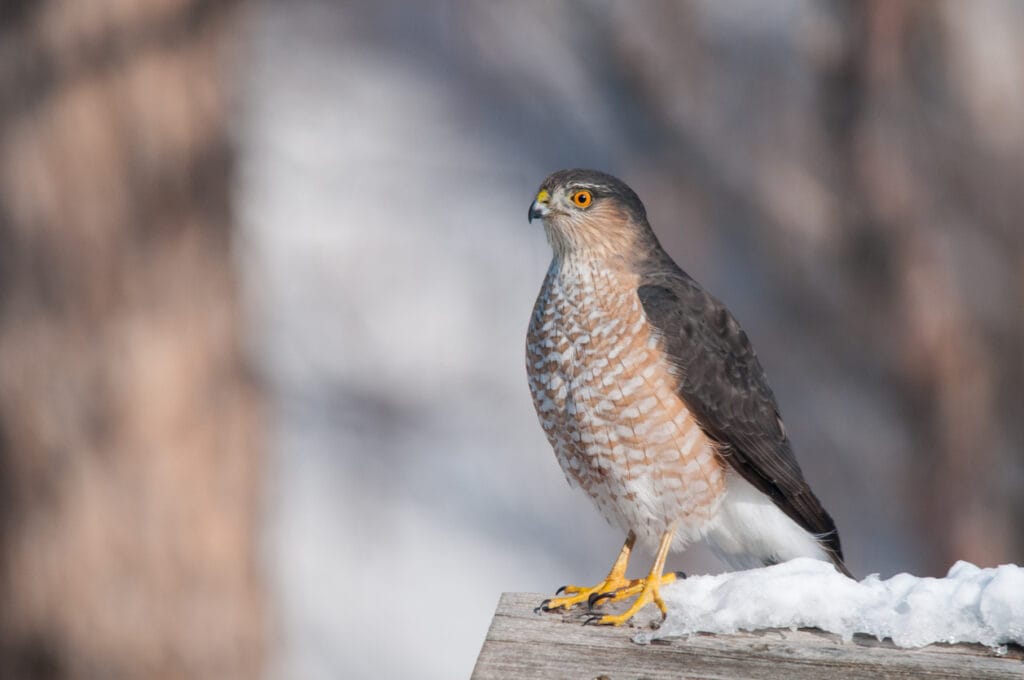
Although it’s not that common, the Sharp-shinned Hawk can be found across the forested areas in Oregon. It’s the smallest hawk in the US and has blue-gray plumage and orange markings on the breast.
It’s an agile raptor that surprises songbirds while they’re flying. Thanks to the dense vegetation, the Sharp-shinned Hawk is able to catch American robins, warblers, thrushes, and sparrows, which make up almost 90% of the bird’s diet.
It also catches bigger birds like doves, swifts, woodpeckers, and even falcons and occasionally feeds on rodents.
Backyard feeders usually attract the Sharp-shinned Hawk, where it targets songbirds. If this happens, you can take your feeder down until the hawk moves elsewhere.
Due to the difference in the size between the male and female, nestlings usually feed on prey caught by the father, then feed on what their mother caught when they get bigger. Male hawks usually eat the prey’s head.
6. Bald Eagle

The Bald Eagle is found in various locations across Oregon, including the Columbia River below Portland, the upper Willamette River Basin, the High Cascade, and the Oregon coast.
It’s a sea eagle that’s usually found around large water bodies surrounded by old trees that the eagle uses for nesting. It mainly feeds on fish, and the head is covered in white feathers, so it’s not really bald. The rest of the body is brown, and it has a large hooked yellow bill.
Rather than catching their fish, Bald Eagles engage in piracy behavior by stealing the catches of other birds of prey, especially Ospreys. The bald eagle approaches the osprey mid-air and grabs the fish from its talons.
Fishing mammals and even people might also lose their catches to this opportunist eagle.
The Bald Eagle has a diverse diet depending on what’s available. In addition to fish, it also feeds on mammals, reptiles, amphibians, birds, and invertebrates. It builds massive nests that can be 5 to 6 feet in diameter and 2 to 4 feet tall.
7. American Kestrel
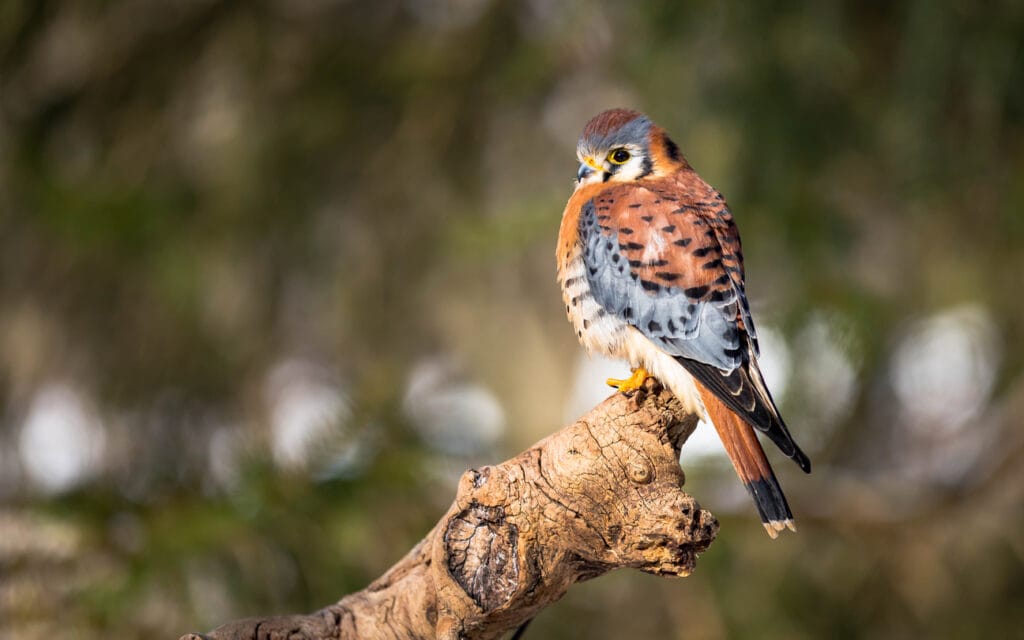
Also known as the sparrow hawk, the American Kestrel is the US’s smallest and most common falcon. In Oregon, it’s usually found near the meadows and fields, as it prefers to hunt in open areas.
Male birds usually weigh 5 ounces, while female birds are slightly larger weighing about 5.8 ounces, so this raptor is almost the size of the Mourning Dove. Despite its small body, the American Kestrel is a fierce and skilled bird of prey.
Top Tip: The male birds have rusty-spotted above and slate-blue wings, while the female birds have reddish-brown wings. Both sexes have black vertical lines under the eyes.
This raptor catches its prey from the ground, usually feeding on insects, rodents, and songbirds. However, the American kestrel can take larger prey like a Northern Flicker in some rare cases.
8. Osprey
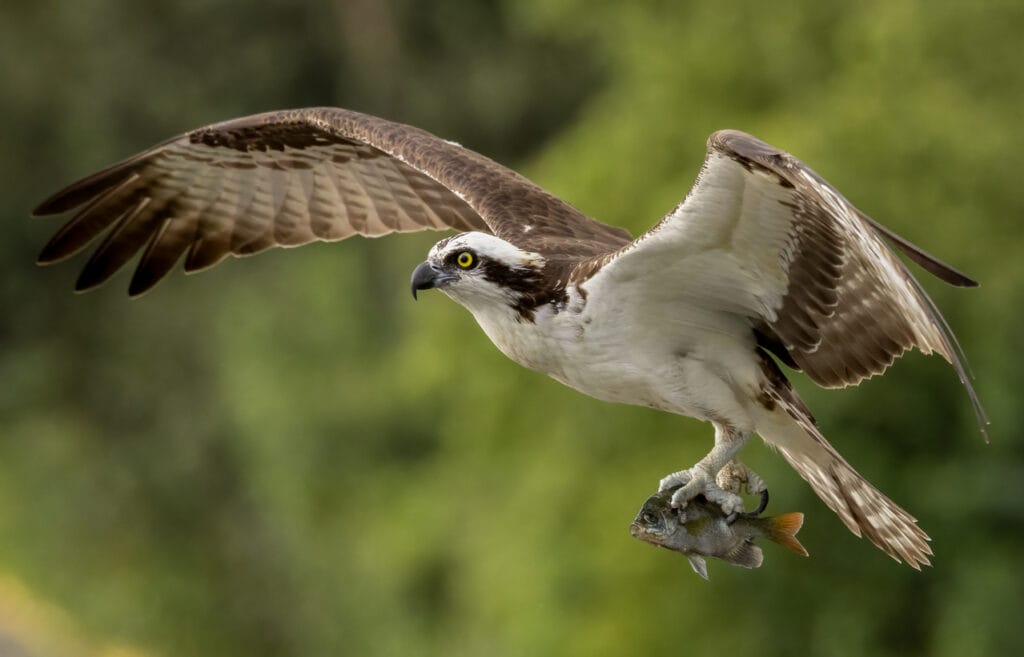
The Osprey is found across Oregon, especially around the coastal areas, rivers, lakes, swamps, and reservoirs. The Osprey isn’t a hawk, although sometimes it’s called the fish hawk or sea hawk.
It’s a large bird of prey that weighs around 4 pounds and 10 ounces. It has brown plumage, white underparts, and a streaked breast.
This raptor is commonly found soaring across shorelines, and it’s not afraid of humans.
Near abundant fish supply, you can listen to the Osprey’s chirping to be able to locate it. If you live in its range, consider putting up a nesting box for a breeding pair before the breeding season begins.
It usually hunts near shallow waters, and there should be an abundant supply of fish within 12 miles of the nest. The nest site is usually elevated to protect the eggs and nestlings from raccoons.
9. Great Gray Owl
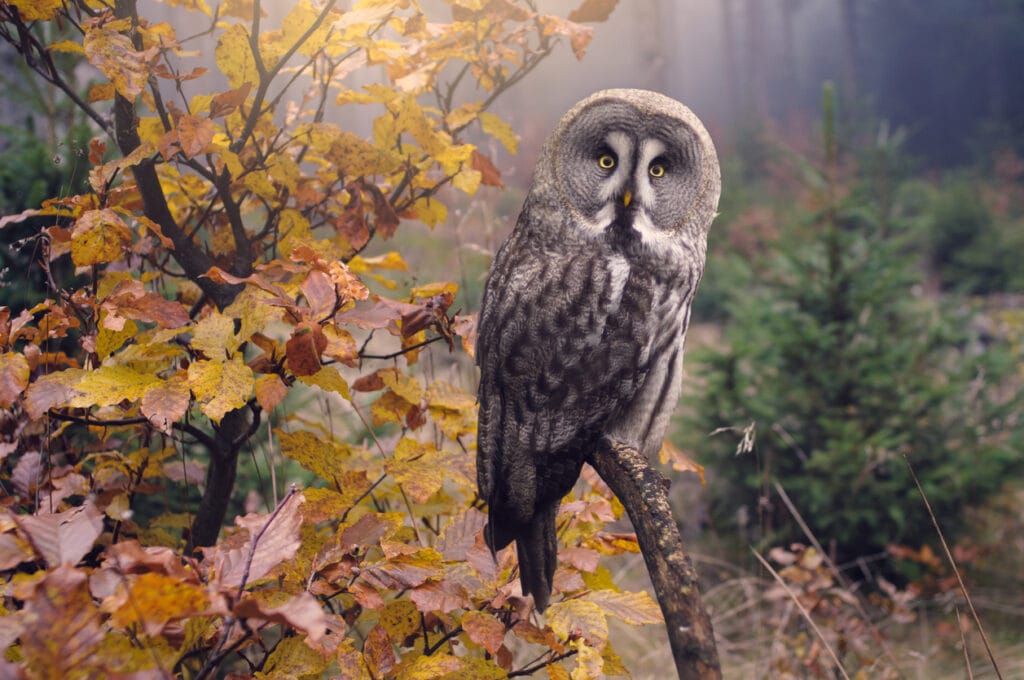
Although not so common to find in Oregon, the Great Gray Owl has been regularly spotted in forests near the Cascades, Wallowa, and Blue mountains. During winter, this owl moves towards lower elevation evergreen forests.
It’s a large owl with a rounded head and gray face. The underparts are streaked, and the upperparts are paler. It makes a deep sound, and the young birds usually hiss.
The owl’s large size is because of its heavy plumage, as smaller owls like the snowy owl usually weigh heavier. This shy bird usually avoids people and perches on the edges of meadows and forests. Despite the owl’s large size, it can remain undetected due to its brilliant camouflage.
When it’s time to hunt, the Great Gray Owl flies low to listen to small mammals and rodents. It feeds on pocket gophers, mice, voles, chipmunks, and lemmings. You can set up a nest to attract a breeding pair to your backyard.
10. Prairie Falcon

The Prairie Falcon is widely found in the open areas of Oregon, including grasslands, pastures, fields, and shrubby deserts. It’s a large falcon with brown above and pale below that also features markings on the belly.
Roosting birds are usually difficult to spot, but during the breeding season, you might hear this falcon’s loud call.
This falcon engages in an astonishing playing activity, where it drops a dried ball of cow manure and dives to catch it. Scientists believe that birds do this to sharpen their coordination skills.
Author Note: Prairie Falcons eat small mammals like ground squirrels. They also eat birds, pikas, and insects.
These falcons defend their territories aggressively, usually chasing the great horned owl, hawks, eagles, and other falcons away from their nests.
11. Swainson’s Hawk
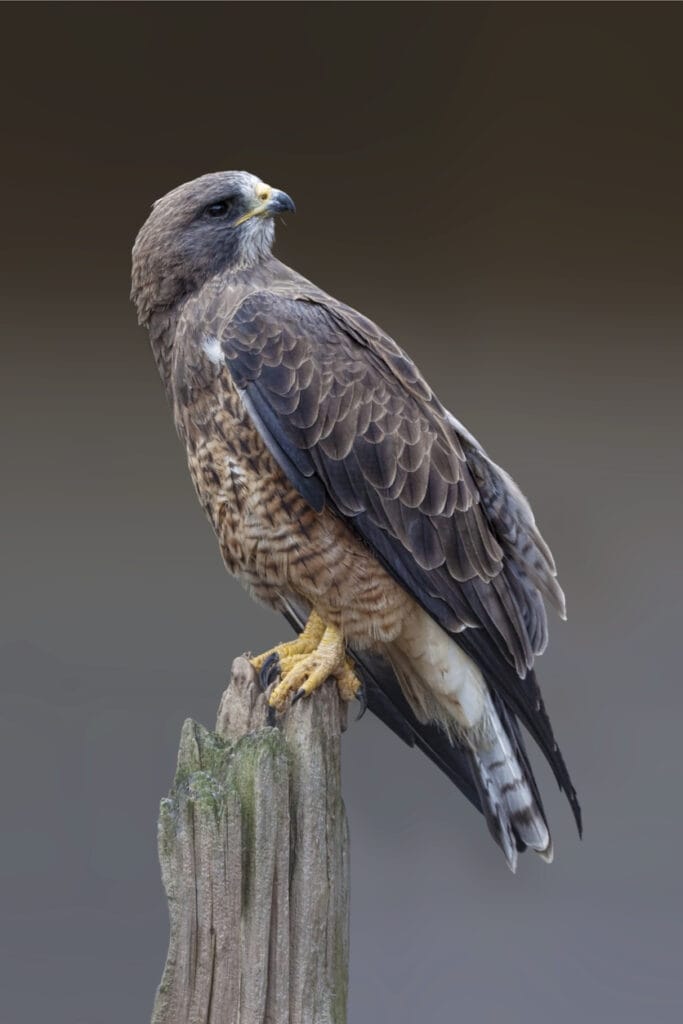
The Swainson’s Hawk is found in an area that stretches from east to the Cascade Mountains to the Blue Mountains. This hawk has gray or brown upperparts and a reddish-brown chest.
There’s also a chance to encounter darker individuals, and they can be completely black, although they’re less common.
It’s quite fond of locusts and grasshoppers, and this is why it’s sometimes called the grasshopper hawk or the locust hawk. It usually hunts insects while they’re flying and eats them on the wing but chases rodents on the ground.
It also feeds on rabbits, gophers, ground squirrels, mice, and voles, especially during the breeding season. In some cases, it might hunt bats, lizards, and other birds.
During the migration season, Swainson’s Hawks form kettles that contain up to tens of thousands of individuals. Turkey Vultures and Broad-winged Hawks usually join these flocks, creating an amazing chance for birders to study these outstanding raptors.
12. Western Screech-Owl
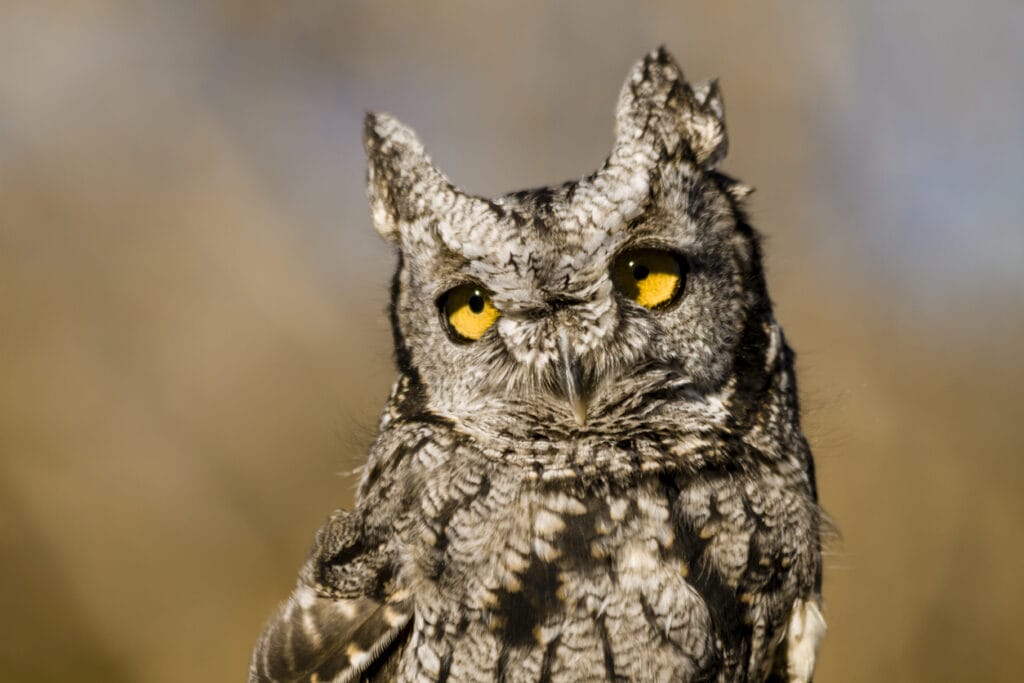
This small owl is an all-year resident, which can be found below 3000 feet in Western Oregon. It prefers to live in deciduous forests, in addition to parks, mountains, suburbs, and deserts.
The Western Screech-Owl is a stocky owl with a square face and almost no neck. Its plumage provides the perfect camouflage as it looks just like the tree bark. It could be grayish, brownish, or reddish, and the belly is paler.
Top Tip: The short repeated hoots announce the presence of this tiny owl, and it usually nests in tree cavities excavated by woodpeckers.
However, it also nests in naturally occurring cavities in trees when a branch is broken or in cliffs.
Despite its small body, this owl can take prey that’s usually larger than its body. It feeds on pocket mice, rabbits, shrews, and bats. It also feeds on birds, amphibians, and fish.
Wrap Up
There’s a chance to spot a bird of prey in almost every part of Oregon as these raptors are widespread.
Some of them don’t even mind visiting your backyard either to breed or to hunt the songbirds and small mammals that might be wandering around. We hope you enjoyed this guide on the most common Oregon birds of prey!
FAQ
Oregon is a great place to find raptors. There are eagles, hawks, falcons and owls all resident in the state. Do your research about where they have been seen and then head out!
That would be the California Condor, it is the largest bird by far. Oregon is on the edge of its range so it is a pretty rare sighting but always worth looking out for.
What kind of vultures live in Oregon?
The Turkey Vulture live in Oregon. Look for them circling over roads as they search for roadkill. They hold their wings in a V shape which helps to identify them. Their red, bald head against all black body is also a giveaway.





